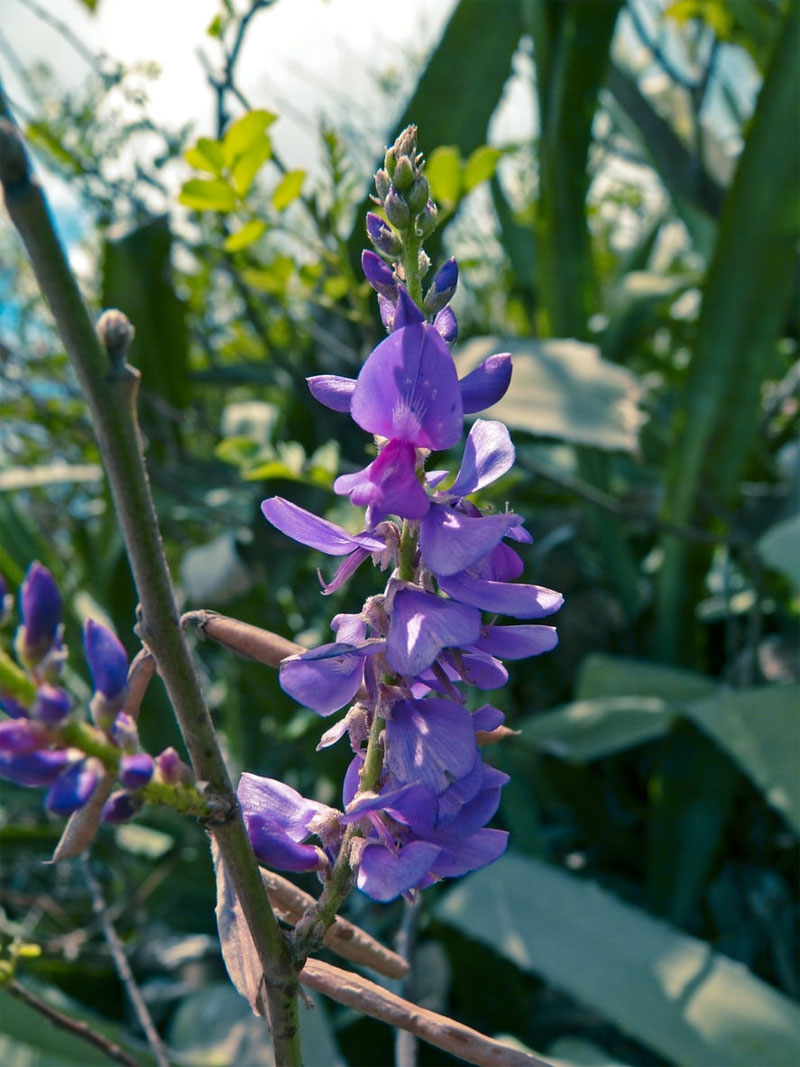
Once the dough trained, it is dried and then powdered. In Ghor Safi, women use pointed cotton bags. Nowadays, cotton cloth works perfectly in this process. The ancient Jordan Valley indigo industry used a special pottery for training the indigo, similar to the sugar ceramic. It may eventually undergo a short heating process or directly be drained. The sediment is then collected in the form of an aqueous slurry. In Ghor Safi, the harvest occurs twice yearly. It can provide annual, biennial or perennial yields depending on the climate. This shrub belongs to the bean family, has green pinnate leaves and pink flowers. Indigofera tinctoria seeds have been brought from India. In Ghor Safi, the modern village located in the area of the ancient Zoara/Sughar, a project initiated by a local women cooperative revives the indigo dyeing. Only few workshops are still known in Syria and the end of the 20 th century. It is the entry of the synthetic indigo on to the markets that fatally damaged this traditional industry. However, indigo was still alive till the beginning of the 20 th century and the Southern end of the Dead Sea was known as one of the best places for its production. Indigo cultivation was still a very common production of the Jordan Valley at the 19 th century, but started declining, as in general the local agriculture in the whole area, affected by an external bureaucratic oppression, the exploitation of the peasantry and the degeneration of the whole farming system crumbling, following the report of the 19 th century travellers, under the inefficiency and the corruption of the governmental Ottoman authority. zaytuni, from zaytun meaning olive), the taffeta (Ar. In the modern textile industry, many fabrics names have their origin directly from the Arab world: the damask (from Damascus), the muslin (from Mosul), the gauze (from Gaza), the baudekin (from Bagdad), the cotton (Ar. From the Jordan Valley, several trade routes were available: to Cairo and the North Africa, to Gaza and through the Mediterranean sea, to Damascus and Istanbul. The textiles of the Arab world represented a large portion of the exportations to Europe. In the Levant, the indigo industry survived much beyond the sugar industry. The indigo industry is an important precursor of the sugar industry and played a role in the early steps sugar processing as it presents some similarities with it in the process as well as in the type of recipients. Today the common plant used to produce indigo is the Indigofera tinctoria, also called the true indigo. However, it is likely that the Isatis tinctoria has been abandoned at the 10 th century due to its poor quality. We know from Arab authors that two kinds of plants were available, possibly the Isatis tinctoria (woad) and a species of Indigofera. The 10 th century geographer Ibn Hawqal reports that the dye workers in Sughar were as numerous as those of Kabul even though the quality of the indigo dye was inferior. belowīefore being famous for its sugar industry, the city of Zoara, in the surroundings of the modern Safi village, was well known for its indigo production. Indigo even became the main crop cultivated in the Jordan Valley. Sughar) are well attested in the writing of the Arab scholars of the 10 th to the 13 th centuries. The production of Baisan in the North of the Valley, of Jericho in the middle and Zoara ( Ar. The tropical climate of the Jordan Valley and the efficient irrigation network perfected through the agricultural technological progresses offered ideal conditions to the cultivation of indigo. The crop was widespread in different areas of the Arab world, notably in Egypt and Yemen. However, with the technological advances that occurred subsequently to the Islamic expansion in Asia, the cultivation of indigo was imported to the Middle East in order to also produce it locally.

The modern Arabic keeps the name nil, from the Sanskrit nila meaning dark blue or darkness. Until the emergence of the prosperous centuries of the Islamic Agricultural Revolution, The Middle East imported indigo from India, as it name suggests it (from Gr.

Indeed, several civilizations have independently developed indigo dyeing from different sources containing indigotin and we find evidences of it in all the ancient civilizations of the Near and Middle East, of India, of China and Japan, of Africa but also of Meso- and South America. Indigo can be produced from different type of plants (about 300 kinds of plants contain the indigotin, the basic chemical compound producing the blue color). It is one of the oldest dyes used for textiles and printing. Among the different types of natural dyes that were in used in the Middle East, indigo holds a special place.


 0 kommentar(er)
0 kommentar(er)
